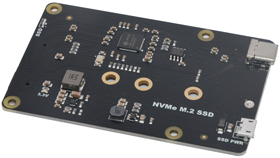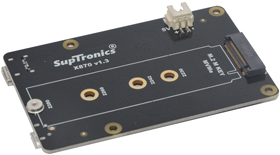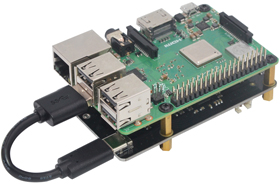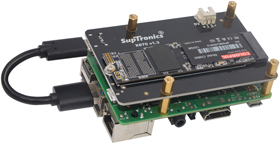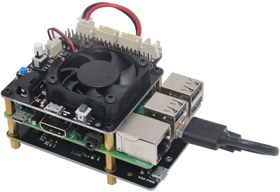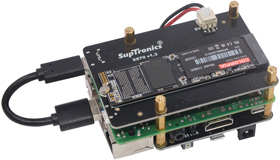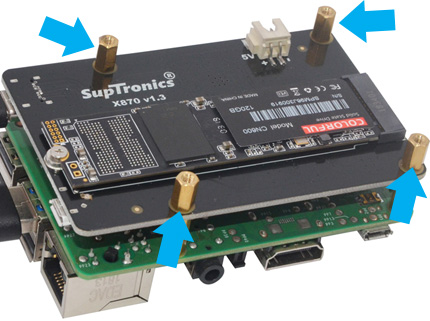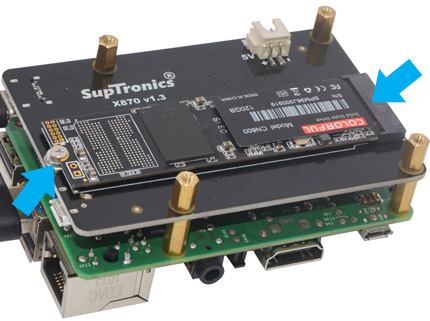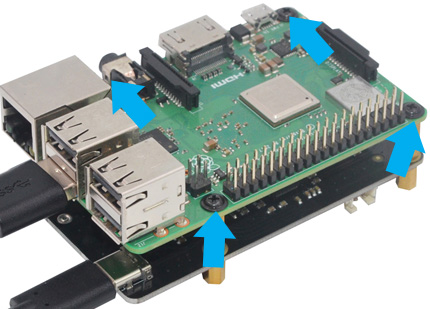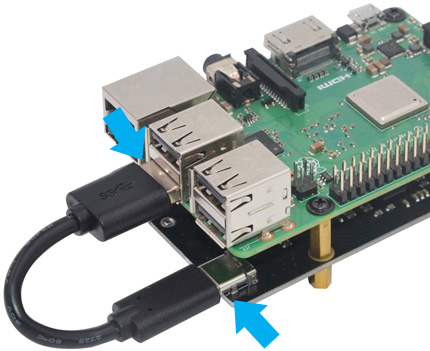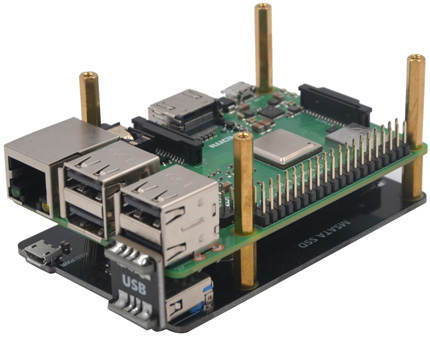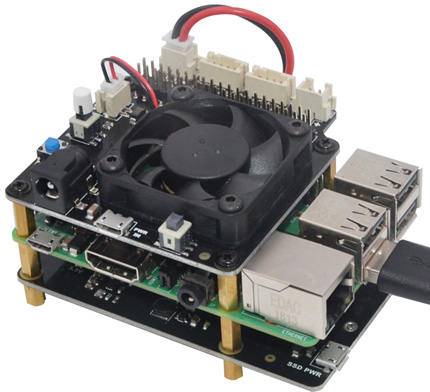EZ-0079
X870 M.2 NVMe SSD Shield
This is the X870 NVMe M.2 SSD Storage Expansion Board, it provides a complete storage solution for raspberry pi or ROCK64.
It supports multiple M.2 NVMe SSD lengths including: 2280, 2260, 2242, 2230.
- FOR USE WITH
Raspberry Pi 1 Model B+/ 2 Model B / 3 Model B / 3 Model B+
- OPERATING SYSTEM
All Raspberry Pi operating systems
Features
- Ideal storage solution for Raspberry Pi - M.2 NVMe SSD Shield
- Supports up to 2TB M.2 NVMe SSD solid-state drives
- Supports multiple M.2 NVMe SSD lengths including: 2280, 2260, 2242, 2230
- Supports operating system installation and booting from your SSD
- Supports fastest OS image writing (>1Gb/S*) from a PC or a Mac
- Integrated USB 3.1 Gen2 to PCIe Gen3x2 10Gb/s bridge controller
- USB2.0 connectivity offers plug-and-play functionality on your Raspberry Pi
- Quick file transfer with high-speed USB3.1 Gen1 5Gb/s or Gen2 10Gb/s connectivity from a PC or a Mac
- LED blue indicator indicates drive status
- On-board micro-USB socket and XH2.5 connector allows external power supply to power high capacity SSD (Max 11.5Watts)
- USB bus-powered
- Specially-made short USB Type-C to USB-A 3.0 cable to connect with Raspberry Pi
- Fully compatible with X720, X730 and X735 for intelligent and safe power management
- PCB Size: 87mm x 56mm
[NOTE]
- *Test condition: USB3.1 Gen 2 port, SSD sequential write speed >1000MB/s
- NVMe SATA SSD is not included
- Compatible with NVMe M.2 SSDs
- Not compatible with M.2 SATA SSDs, M.2 PCIe AHCI SSDs, or other M.2 non-NVMe devices
- As with all SSDs, new media must be formatted before use
- Performance depends on host system, workload, and SSD media used
- SSDs use exceptionally high performance storage media that will run hot when under load
- Older SSD drives with less efficient flash media may not perform as well as newer drives
Power supply request
5Vdc +/-5% , Powered by Raspberry Pi
Additional power supply for SSD (Only when you find that the power supply of the SSD is insufficient)
5Vdc via on-board micro-USB or XH2.5 2Pin connector
Note: When use X860 board with X735 Safe Shutdown Power Management & Auto Cooling Expansion Board togehter, the power adapter must be connected to X735 power managment board only, not X860 or Raspberry Pi.
Ports & Connectors
- USB socket - USB Type-C x 1
- Micro-USB SSD power socket x 1
- XH2.54 2P SSD power input port x 1
- 67Pin M.2 connector P=0.5mm, H3.2mm, Key B x 1
Package Includes
- 1 x X870 Board
- 1 x USB3.0 Type A to Type C cable(length: 10cm)
- 4 x Spacer F/F M2.5x8
- 4 x Spacer M/F2.5x12
- 4 x Screw M2.5x4
- 1 x Screwdriver
Gallery
Installation Guide
Push a M/F spacer (M2.5*12mm) up through the mounting hole on the topside of the X870 and screw down with a F/F spacer (M2.5*8mm)
a) Insert your M.2 NVME SSD into the M.2 socket. b) Align the notches on the SSD with the notches in the M.2 socket, then insert as shown. c) Screw (M2*4mm) the SSD into place.
Place your Raspberry Pi on top of X870 and screw down (M2.5*6mm screws).
Connect the USB data cable from Raspberry Pi to X870
Optional -To use with X730 / X735 /X700 /720 power management board, a) Unscrew 4 screws on the topside of Raspberry pi b) Screw the spacer (M2.5*12mm / M2.5*20mm) down until it is hand tight
Plugs the power management board straight into your Raspberry Pi's GPIO header and screw down (M2.5*6mm)
Connect the 2-pin power connection wire from the 5V connector on Power management board to X870
Power adapter must be connected to power management board only , not X870 and Raspberry Pi
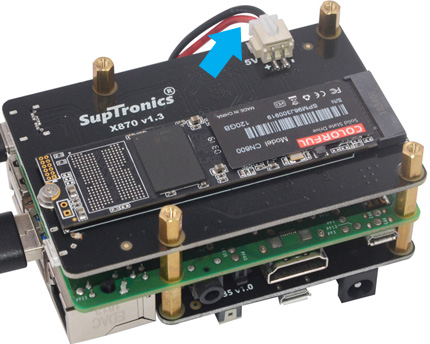
Booting from the X8 series storage board
This tutorial explains how to boot your Raspberry Pi 3 from the X8 series (X820 V3.0, X850 V3.0, X822, X852, X860, X870) storage board
Program USB Boot Mode
Before a Raspberry Pi 3 will boot from the X8 series storage board, it needs to be booted from an SD card with a config option to enable USB boot mode.
This will set a bit in the OTP (One Time Programmable) memory in the Raspberry Pi SoC that will enable booting from the X8 series storage board.
Once this bit has been set, the SD card is no longer required.
Note that any change you make to the OTP is permanent and cannot be undone.
You can use any SD card running Raspbian or Raspbian Lite to program the OTP bit.
If you don't have such an SD card then you can install Raspbian or Raspbian Lite in the normal way - see [ installing images | https://www.raspberrypi.org/documentation/installation/installing-images/README.md ]
First, prepare the /boot directory with up to date boot files:
$ sudo apt-get update && sudo apt-get upgrade
The above step is not required if you use the 2017-04-10 release of Raspbian / Raspbian Lite or later.
Then enable USB boot mode with this code:
echo program_usb_boot_mode=1 | sudo tee -a /boot/config.txt
This adds program_usb_boot_mode=1 to the end of /boot/config.txt.
Reboot the Raspberry Pi with sudo reboot, then check that the OTP has been programmed with:
$ vcgencmd otp_dump | grep 17:
17:3020000a
Ensure the output 0x3020000a is shown.
If it is not, then the OTP bit has not been successfully programmed.
If you wish, you can remove the program_usb_boot_mode line from config.txt, so that if you put the SD card in another Raspberry Pi, it won't program USB boot mode.
Make sure there is no blank line at the end of config.txt.
You can edit config.txt using the nano editor using the command:
sudo nano /boot/config.txt , for example.
Prepare the operating system image
Starting with the 2017-04-10 release of Raspbian you can install a working Raspbian system to the X8 series storage board by copying the operating system image directly onto it, in the same way that you would for an SD card.
To perform this step, follow the instructions here, remembering to select the drive that corresponds to your X8 series mass storage device.
Once you have finished imaging your X8 series storage board,
remove the USB data cable from your computer and insert the USB bridge into your Raspberry Pi and X8 series storage board USB ports.
Boot your Raspberry Pi 3 from the USB mass storage device
Powering it up.
After between five and ten seconds the Raspberry Pi should begin booting, and display the rainbow splash screen on an attached screen.
Document
How to boot from X870, you can refer to How to boot from a USB mass storage device on a Raspberry Pi
FAQ
- Q: Should I must change the boot sequence to my HDD/SSD ?
A: No, it's all depends on you.
- Q: How to make a NAS storage from this product?
A: 1. You need to part your partition by using fdisk command and make filesystem by using mkfs command, and create a directory and mount you disk on.
2. install samba software by using apt-get install samba and modify the configuration file /etc/samba/smb.conf and start the samba service.
- Q: Cloud it be used on Pi4B?
A: No.
Keywords
- X870, M.2 NVMe SSD Shield, NAS, storage, Raspberry pi
